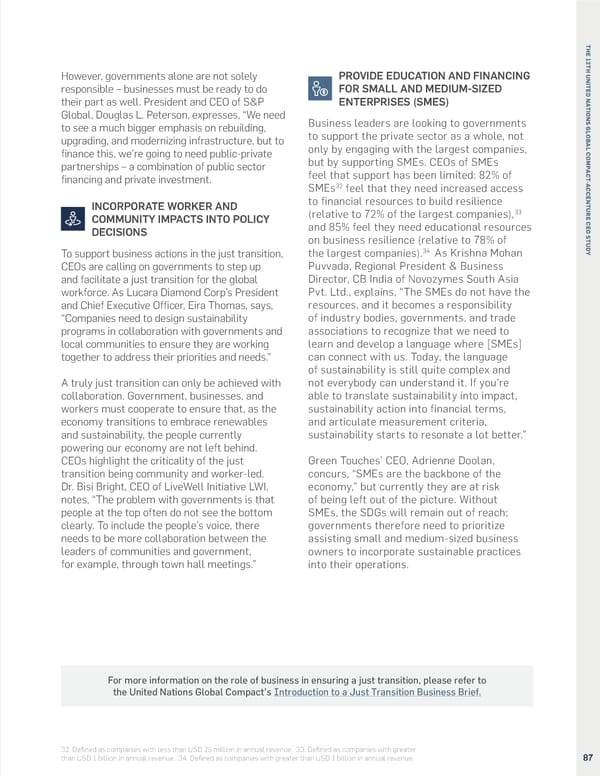T H E 1 2 T H U ENABLE THE CIRCULAR ECONOMY However, governments alone are not solely PROVIDE EDUCATION AND FINANCING N I T THROUGH ESTABLISHING STANDARDS responsible – businesses must be ready to do FOR SMALL AND MEDIUM-SIZED E D N FOR TRANSBOUNDARY MOVEMENT their part as well. President and CEO of S&P ENTERPRISES (SMES) A T I O Global, Douglas L. Peterson, expresses, “We need N Businesses are increasingly trying to move to a more Business leaders are looking to governments S G to see a much bigger emphasis on rebuilding, L O circular business models to not only counter current to support the private sector as a whole, not B upgrading, and modernizing infrastructure, but to A geopolitics, economic uncertainty, and increasing costs, only by engaging with the largest companies, L C finance this, we’re going to need public-private O but also proactively address future concerns, such as M but by supporting SMEs. CEOs of SMEs P partnerships – a combination of public sector A C resource shortages or upcoming regulations. feel that support has been limited: 82% of T financing and private investment. - A 32 C SMEs feel that they need increased access C E N Governments are a key player in the circular transition to financial resources to build resilience T INCORPORATE WORKER AND U 33 R and have multiple levers to pull, including raising COMMUNITY IMPACTS INTO POLICY (relative to 72% of the largest companies), E C E standards for recycling and repairing products, DECISIONS and 85% feel they need educational resources O S T providing incentives for sustainable products and on business resilience (relative to 78% of U D services, and removing regulatory barriers. As CEO 34 Y To support business actions in the just transition, the largest companies). As Krishna Mohan of Braskem, Roberto Simões, says, “Support from CEOs are calling on governments to step up Puvvada, Regional President & Business governments and international bodies in supporting and facilitate a just transition for the global Director, CB India of Novozymes South Asia the circular economy and sustainability initiatives workforce. As Lucara Diamond Corp’s President Pvt. Ltd., explains, “The SMEs do not have the is key to speeding up the implementation of strong and Chief Executive Officer, Eira Thomas, says, resources, and it becomes a responsibility actions for carbon reduction.”“Companies need to design sustainability of industry bodies, governments, and trade programs in collaboration with governments and associations to recognize that we need to Specifically, CEOs are calling on governments to local communities to ensure they are working learn and develop a language where [SMEs] develop standards for transboundary movement – the together to address their priorities and needs.” can connect with us. Today, the language movement of products/waste products across country of sustainability is still quite complex and or regional borders. Without internationally accepted A truly just transition can only be achieved with not everybody can understand it. If you’re standards for transboundary movement, companies collaboration. Government, businesses, and able to translate sustainability into impact, struggle with reclaiming their products, even if they workers must cooperate to ensure that, as the sustainability action into financial terms, are designed to be circular. These regulations, while economy transitions to embrace renewables and articulate measurement criteria, put in place to protect the public from toxic materials, and sustainability, the people currently sustainability starts to resonate a lot better.” are having an unintended consequence of limiting the powering our economy are not left behind. viability of a global, circular economy.CEOs highlight the criticality of the just Green Touches’ CEO, Adrienne Doolan, transition being community and worker-led. concurs, “SMEs are the backbone of the INVEST IN SUSTAINABLE BASIC Dr. Bisi Bright, CEO of LiveWell Initiative LWI, economy,” but currently they are at risk INFRASTRUCTURE, INCLUDING ROADS, notes, “The problem with governments is that of being left out of the picture. Without BRIDGES, AND ENERGY SYSTEMS people at the top often do not see the bottom SMEs, the SDGs will remain out of reach; clearly. To include the people’s voice, there governments therefore need to prioritize One of the most impactful levers that governments needs to be more collaboration between the assisting small and medium-sized business can pull is investing in sustainable infrastructure. With leaders of communities and government, owners to incorporate sustainable practices this investment in sustainable, equitable infrastructure, for example, through town hall meetings.”into their operations. there is not only an opportunity to make a positive environmental and social impact, but also the possibility of creating new markets for sustainable products, services, and processes. As Paul Abbott, CEO of American Express Global Business Travel (Amex GBT), says, “At the moment, sustainable technologies and innovations, such as sustainable aviation fuels, are the only way we can make significant progress. And that won’t happen unless there is massive For more information on the role of business in ensuring a just transition, please refer to infrastructure investment, primarily from governments, the United Nations Global Compact’s Introduction to a Just Transition Business Brief. to drive long-term structural change.” 32. Defined as companies with less than USD 25 million in annual revenue. 33. Defined as companies with greater 86 than USD 1 billion in annual revenue. 34. Defined as companies with greater than USD 1 billion in annual revenue. 87
 Accenture CEO Study United Nations Global Compact Page 86 Page 88
Accenture CEO Study United Nations Global Compact Page 86 Page 88